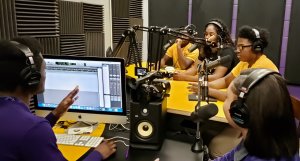There’s an App for That—School Counseling and SEL Go Online
From virtual counseling to wellness apps, school districts are increasingly turning to “telehealth” to meet students’ mental health needs during the pandemic.
Your content has been saved!
Go to My Saved Content.It’s a Thursday afternoon and I’m meeting on Zoom with Yafae and Elijah, two Chicago high school sophomores, and their teacher Melissa Hughes—all of us at home due to coronavirus mandates.
While teachers and parents around the country fret about the transition to home-based learning during the pandemic, the boys say that’s not what they’re worried about. They’re thinking about the other impacts of being home—namely the loss of connections, experiences, and memories made at school.
“Some people really rely on other people to make them happy. They get joy coming to school and seeing their friends,” said Yafae, who tells me he hasn’t gone outside since the weekend but is itching to go for a run to stay in shape for football. “A lot of my peers are scared,” adds Elijah. “We can’t really do anything. We can’t go places… There’s just a lot of stuff going on in my head.”
It was only a few weeks ago that the boys and their peers were notified that their school, like schools across the nation, was closing its doors. As teachers and students hastily prepared for the transition, the boys did their own scrambling—to record a series of podcasts about the stress and uncertainty many kids were experiencing. On one episode, a social worker talks young listeners through mindful breathing exercises to calm the brain; on another, a counselor reminds students "an idle mind is the devil's playground,” and encourages them to brainstorm activities like playing video games, doing pushups, and reading books to cope with being home.

The boys’ novel response to the circumstances—a mix of new technologies and more traditional counseling known as “telehealth” or “teletherapy”—is now being adopted in a hurry by school districts around the country. Seeking new avenues to reach kids without direct access to school-based services, counselors and social workers are now connecting via video conference, apps, and phone calls, or working directly with teachers to embed social and emotional practices into their remote teaching.
Counselors, principals, and teachers share their new approaches:
The Big Privacy Question
Regulations around the privacy of minors—who had limited telehealth offerings in schools in the past—are being loosened during the pandemic, allowing districts to offer virtual counseling and therapy sessions for students who need it, according to Debbie Plotnick, a vice president at Mental Health America, who says it may set a new precedent for school-based health care.
Students who were already receiving services at school can continue one-to-one sessions (or even group therapy) by video or phone. Some districts, such as Onslow County Schools in North Carolina and Seattle Public Schools, are also providing the option for any student who feels they need to talk. For counselors or psychologists who are new to running virtual therapy sessions, national organizations like the National Center for School Mental Health and the American School Counselors Association are offering resource pages and videos with guidelines.
Given the legal implications, educators recommend being fully transparent about the risks of virtual settings, and asking families to provide explicit consent for virtual counseling. In the San Carlos, California, school district, for example, an email was sent out to parents of children receiving counseling services notifying them that absolute privacy cannot be guaranteed using telecommunications platforms, and getting confirmation they were comfortable with it.
There's an App for That
Educators are also turning to a wide array of digital tools that provide everything from breathing exercises and journaling prompts to quick options to check on a students’ mental health. Alex Shevrin Venet, a college professor and former administrator at a therapeutic high school, recommends the SuperBetter app, which uses digital games like “fulfilling a quest” or “recruiting allies” to teach kids social and emotional skills like cooperation and persistence. The popular Calm app, which focuses on relaxation, also features activities just for kids.
Designed with help from high school students, the new Atlas app offers users a library of podcasts—updated weekly—featuring students’ own stories on stress and ruminations on their lives. The reflections are paired with “techniques and strategies that you would find in evidence-based therapies to help students work through whatever they're going through,” said Max Savage, one of the co-founders, who is now offering the app for free during coronavirus school closures. Forty-two schools are currently partnered with Atlas.
Apps can even serve very young learners. A pre-k program in Ohio recently tested out GoogleDuo—a video communications app with stringent privacy standards—to conduct virtual counseling with 3-5 year olds from families with a history of trauma. Though the children struggled a bit to sit still and adapt to the medium, the educators worked through the problems. “There's nothing that's going to substitute” for face-to-face counseling, said one mental health counselor, but the program is now considering using the app for summer extensions after the pandemic ends.
Embedding Virtual Touchpoints
Regular touchpoints like online check-ins can also help ensure kids are tethered to the school community and aren’t slipping through the cracks, say educators and counselors we talked to.
Sarahi Monterrey, the 2018-2019 Wisconsin State Teacher of the Year, says she’s started asking students how they are feeling in her daily Google attendance form as a way to keep tabs on students’ mental health, for example. Other teachers suggest monitoring attendance in digital classrooms carefully, then notifying counselors if a student is chronically absent or unengaged in activities so they can reach out directly.
Meanwhile, Phyllis Fagell, a school counselor in Washington, D.C., recommends teachers and counselors carve out time to have students do non-academic activities online together like play games and participate in book clubs, lunch groups, or small group projects to give them moments of “joy and relief” with their peers.
It’s also important for counselors and educators to connect with parents/caregivers to understand the best ways to reach them and to get a sense of what’s going on at home, says Mathew Portell, a principal of a Title I elementary school in Nashville, Tennessee, who has made it a priority to call all 325 families at his school during the closure.
“What we're learning right now is that the majority of our parents are in survival mode; they need comfort and somebody they trust and talk to,” said Portell, who plans to continue the practice into next school year.
Always-On Portals
Online portals stocked with social and emotional resources can be a rich, asynchronous destination for parents and teachers to support students’ mental health on their own time.
In the San Carlos school district, counselors set up an online portal that provides weekly social and emotional learning (SEL) activities teachers or parents can use on topics like emotion regulation and calming/breathing routines. Similarly, Sarah Kirk, an elementary school counselor in Oklahoma, has set up a page on her class website dedicated to the coronavirus that provides a list of SEL resources for families and teachers, such as books about identifying feelings, games that teach self-regulation skills, and reflective activities to do while watching TV or movies.
Community Partners
Some districts recommend working collaboratively with health care providers in their communities to extend their reach to more students.
A number of providers, who already have experience with telehealth, are offering pro bono or heavily discounted costs for virtual counseling services during this time, according to educators. In New York City, for example, 60 community agencies are now partnering with local schools to support students’ mental health, while in San Carlos, California, schools are working directly with the local One Life Counseling Center, which offers reduced-cost and free services for families in need.
A Note of Caution
Mental health professionals urge caution with all digital outreach, given that not all families have the resources to stay tapped in virtually, and recommend educators consider ways they can reach everyone—whether it be by phone, text messages, or even letters sent home.
Additionally, while mental health professionals encourage schools to address students’ and families’ immediate needs, they are mindful they may face challenging issues ahead—like a family’s changing circumstances, and loss of jobs or even lives—that will have significant impacts on students as they transition back to school.
But though the pending issues are grave, mental health professionals retain some optimism that the digitals tools will provide new ways to connect with and support students now—and when the pandemic ends. “We’ve got to see the silver lining in all of this,” said Melissa Reeves, past president of the National Association for School Psychologists. “It’s a new skill set that might enable us to increase and provide services in ways we haven’t in the past to reach more students.”
